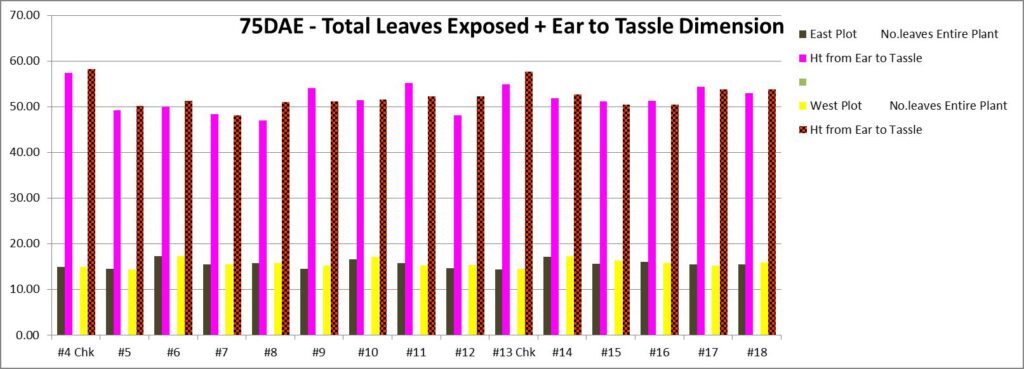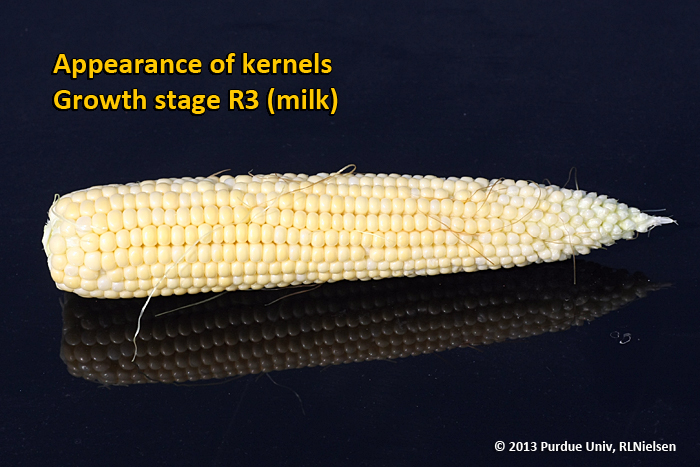Published July 31, 2020 | By Mike Petersen
Image 1 Above:
A typical ear at R3 stage of reproduction – Orthman Research Farm much like this Courtesy: Purdue Univ.
Tis the season to be grateful and thankful we have got to this point. Our corn is right in the stage of R2-R3, kernels are turning yellow and getting juicy. WE have kept Pat busy irrigating via gated pipe twice with a couple of nicely timed rains to keep the corn in real fine moisture conditions. The two hybrids we planted are coming along nicely. Below and to the right is a similar image of what our corn is as of the week of July 26-31, 2020.
We want to show you a couple of points from the data we collected in our Pre-plant/Starter/2X Sidedress fertilization program; the chart below depicts 15 of the 18 plots we have in this study and the varying treatments of how we fertilized the crop with differing amounts of N-P-K-Zn etc. We varied the pre-plant total quantity of nutrients supplied to us by Nutrien™ and the amount sidedressed with the cultivator at ditching time. Our corn near Polk, Nebraska is furrow irrigated via pipe, thus the ditching operation. It is our intent in this study we are carrying out to look at how we can use less fertility partly because of accurate placement under the seed early then come alongside and get more nutrients up close to the plant stalk and root system. With that we are aiming to keep the Nitrogen to each bushel we produce under 1 lb./bushel of yield – preferrably 0.7-0.8lb/bushel.
In the graphic below as we are taking account of crop growth above and below ground, we looked at all plots for height of the plant from the ear to tassle and total leaf number as well as several other characteristics. The first three plots #1, #2, #3 all took a hit from a severe wind at a rapid growth period and received 25-35% greensnap and leaning corn. Lucky us! That which did not snap and leaned over is now back upright but still has something of a lean to the SW. So we stayed out of those three plots to measure, the going would have been worse than a corn maze at sundown. The hybrid is all the same a Pioneer 110-111 RMD product.
With this graphic we have 900ft length of plots divided into two 450 ft increments to study a rate change of the last sidedress pass by the westerly plots having 10 gal more per acre than the eastern 450 ft plots. The plots are 24 rows wide except for the two controls within the study, which are designated as such.
In plots 5 thru 8 we applied less sidedress total by 12 gpa at time of the spring strip till operation across both the east and west 450 lengths. Then at sidedress and ditching the corn we applied 10 more gallons/acre of the nutrient mix which are identified in the graphic with black and red checkered fill. In general we see a small difference in plots 9-13 and then 15-18 compared to 5-8 and 14-15. From casual walk through we see more two eared plants in 9-12 and 16-18. Our plans are to actually take 1/1000th of an acre counts of plants across those plots to identify the number of 2 eared stalks. In nearly all cases that means more yield of grain for folks.
Another detail we have observed in the plots,the late N with S, B and a carbon product, we observed just over 17 total leaves in plots 6, 10 & 14. Those plots are predominantly with ProZinc-10 in the starter mix. Interesting to all of us. In the first check #4 the late Nitrogen added shot the plant height from the ear to the tassle but it did not put on any more leaves, it did show us a 5% increase in greensnap over those with an improved starter program.
Stay with us as we continue to measure plant characteristics in the coming weeks. That is an update as of July 31.

